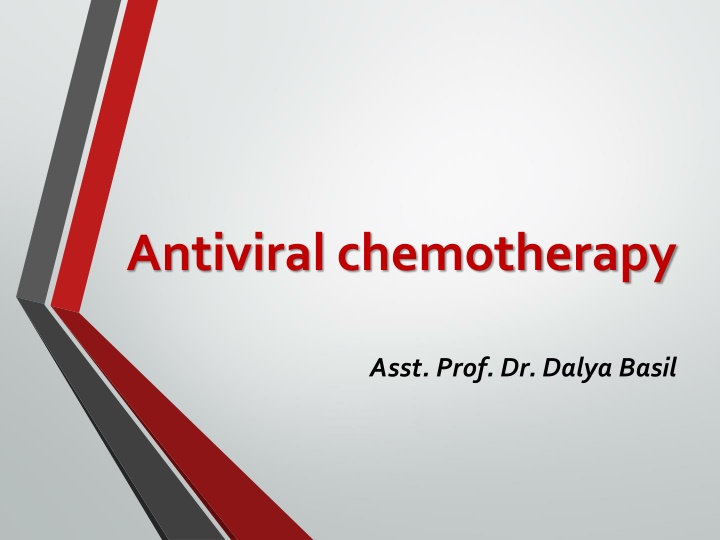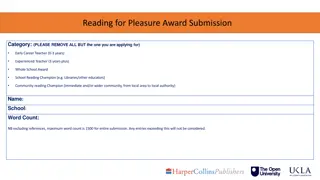Engaging Students with Geography Reading
In this presentation, Emily Chandler (@ChandlerGeog) shares strategies to enhance students' literacy, geographical knowledge, writing skills, and independence through engaging reading activities. She emphasizes linking books to topics, supporting EAL/SEN learners, increasing student interest, and encouraging reading beyond the classroom with wider reading lists.
Download Presentation

Please find below an Image/Link to download the presentation.
The content on the website is provided AS IS for your information and personal use only. It may not be sold, licensed, or shared on other websites without obtaining consent from the author.If you encounter any issues during the download, it is possible that the publisher has removed the file from their server.
You are allowed to download the files provided on this website for personal or commercial use, subject to the condition that they are used lawfully. All files are the property of their respective owners.
The content on the website is provided AS IS for your information and personal use only. It may not be sold, licensed, or shared on other websites without obtaining consent from the author.
E N D
Presentation Transcript
Antiviral chemotherapy Asst. Prof. Dr. Dalya Basil
Antiviral Chemotherapy (Prevention and Treatment of Viral Infection) Viruses are a leading cause of disease and death worldwide. Although public health measures and vaccines are the most effective ways to control many viral infections, preventive succeeded for numerous viral diseases. For some of thesediseases,antiviral drugshavebeendeveloped. measures have not
Antiviral Chemotherapy (Prevention and Treatment of Viral Infection) Because viruses are obligate intracellular parasites, antiviral agents must be capable of selectively inhibiting viral functions without damaging the host, making the development ofsuchdrugsverydifficult. Another limitation is that many rounds of virus replication occur during the incubation period and the virus has spread before symptoms appear, making a drug relatively ineffective. There is a need for antiviral drugs active against viruses for which vaccines are not available or not highly effective.
Types of Antiviral Agents 1- Nucleoside Analogs 2- Nucleotide Analogs 3- Nonnucleoside Reverse Transcriptase Inhibitors 4- Protease Inhibitors 5- Fusion Inhibitor
Nucleoside Analogs The majority of available antiviral agents are nucleoside analogs. They inhibit nucleic acid replication by inhibition of polymerases for nucleic acid replication. In addition, some analogs can be incorporated into the nucleic acid and block furthersynthesis oralter its function. Analogs can inhibit cellular enzymes as well as virus- encoded enzymes. The most effective analogs are those able to specifically inhibit virus-encoded enzymes, with minimal inhibition ofanalogoushostcell enzymes.
Nucleoside Analogs Virus variants resistant to the drug usually arise over time, sometimes quite rapidly. The use of combinations of antiviral drugs can delay the emergence of resistant variants (eg, "triple drug" therapy used to treat HIV infections). Examples of nucleoside (acycloguanosine), lamivudine (3TC), ribavirin, vidarabine (adenine arabinoside), and zidovudine (azidothymidine; AZT). analogs include acyclovir
Nucleotide Analogs Nucleotide analogs differ from nucleoside analogs in having an attached phosphate group. Their ability to persist in cells for long periods of time increases their potency.Cidofoviris anexample.
Non nucleoside Reverse Transcriptase Inhibitors Nevirapine nonnucleoside reverse transcriptase inhibitors. It does not compete with nucleoside triphosphates. It acts by binding directly to reverse transcriptase and disrupting the enzyme's catalytic site. was the first member of the class of
Protease Inhibitors Saquinavir was the first protease inhibitor to be approved for treatment of HIV infection. It is a peptidomimetic agent designed by computer modeling as a molecule that fits into the active site oftheHIVprotease enzyme.
Protease Inhibitors Such drugs inhibit the viral protease that is required at the late stage of the replicative cycle to cleave the viral gag and gag-pol polypeptide precursors to form the mature virion core and activate the reverse transcriptase that will be used in the next round of infection. Inhibition ofthe protease yields noninfectious virus particles.
Fusion Inhibitor Fuzeon is a large peptide that blocks the virus and cellular membrane fusion step involved in entry of HIV-1 into cells.
Other Types of Antiviral Agents Other Types of Antiviral Agents have been shown to possess some antiviral activity undercertain conditions. 1. Amantadine & rimantadine: These synthetic amines specifically inhibit influenza A viruses by blocking viral uncoating. They must be administered prophylactically to haveasignificant protective effect. 2. Methisazone: Methisazone is of historical interest as an inhibitor of poxviruses. It was the first antiviral agent to be described and contributed to eradicate smallpox. It blocked a late stage in viral replication, resulting in the formationofimmature,noninfectious virus particles.
Mechanisms of Specific Antiviral Drugs In principle, any stage of viral infection can be targeted for inhibition. There are potential advantages to targeting very early or late stages such as attachment, entry, and release, because inhibitors of these steps do not have to enter cells to exert activity.
Mechanisms of Specific Antiviral Drugs Stages such as genome replication, assembly, and maturation often require specific viral enzymes, which, are attractive drug targets. Indeed, most antiviral drugs currently available inhibit genome replication. Nevertheless, there is an antiviral drug for nearly every stage of viral infection.
Inhibition of Viral Attachment and Entry Inhibition subsequent steps in virus infection and permits the virion to be cleared by immune and other mechanisms. Two general approaches have been used for drugs that inhibit attachment and entry. The first of these approaches has been to discover drugs that bind to the virion and block these events. Enfuvirtide (T-20) was the first drug approved forclinical use that acts this way. of attachment and entry prevents all
Inhibition of Viral Attachment and Entry This agent was discovered by a rational, directed approach that examined the ability of peptides to inhibit HIV infection in cell culture. The peptide that was most potent (T-20) is similar to a segment of gp41, the HIV protein that mediates membranefusion. A relatively new approach to inhibitors of attachmentand entry has been to target cell surface receptors that mediate these events. Examples of this approach are anti-HIV drugs that inhibit binding to the CCR5 coreceptor, which is used by the most commonly transmitted HIV-1strains (R5 tropic).
Inhibition of Viral Uncoating The adamantane derivatives, rimantadine, are active exclusively against influenza A virus. In most influenza A strains, these drugs inhibit virus uncoating. Influenza A virus attaches to surface glycoproteins, and boundtoits receptor,then inter by endosome. As part of its normal function, the endosome becomes acidified. During influenza virus entry, this reduction in pH causes a conformational change in the virion hemagglutinin protein and fusion of the virion envelope and the endosomal membrane. By itself, this action wouldrelease viral ribonucleoproteininto the cytoplasm. amantadine and
Inhibition of Viral Uncoating In the presence of amantadine or rimantadine, however, the matrix protein, M1, does not dissociate from the ribonucleoprotein, which remains in the cytoplasm instead ofentering the nucleus. Low pH can promote the dissociation of M1, and allow nuclear entry of the ribonucleoprotein. Thus, it is thought that M2in the virion envelope functions to let H+ions from the acidified endosome enter the virion, and dissociate M1fromthe ribonucleoprotein. Amantadine and rimantadine would block the entry of H+ ions, thereby preventing this uncoatingevent.
Inhibition of Viral Genome Replication Most antiviral drugs inhibit viral genome replication, and nearly all of these inhibit a DNA polymerase include certain human herpesviruses, the retrovirus HIV, and the hepadnavirus HBV. Most of these drugs are nucleoside analogues. All nucleoside analogues phosphorylation, usually to the triphosphate form, to exert their effect. Phosphorylated nucleoside analogues inhibit polymerases by competing with the natural dNTP substrate; they are usually also incorporated into the growing DNA chain, where they often terminate elongation. must be activated by
Inhibition of Viral Genome Replication Selectivity, therefore, depends on how much more efficiently viral enzymes phosphorylate the drug than do cellular enzymes, as well as how much more potently and effectively viralgenome replication is inhibited than are cellular functions. The two main categories antiherpesvirus agents (e.g. Acyclovir &Ganciclovir)and anti- HIV agents. Three of these agents (adefovir, lamivudine, and entecavir) are approved for use against HBV. Another nucleoside analog, ribavirin, is used clinically against HCV and respiratory syncytialvirus. of nucleoside analogs are
Inhibition of Viral Assembly and Maturation Protease Inhibitors Virus assembly and subsequent events to form an infectious virion are attractive targets for drug discovery because they are unique to virus biology. For many viruses, including HIV, assembly of proteins and nucleic acid into particles is not sufficient to produce an infectious virion. For such viruses, an additional step, maturation, is required. In most cases, these viruses encode proteases that are essential for maturation. The approved antiviral drugs that target HIV protease (saquinavir, ritonavir, amprenavir, indinavir, nelfinavir, lopinavir, andtipranavir.
Inhibition of Viral Release Anti-influenza Virus Neuraminidase Inhibitors Inhibitors of influenza neuraminidases block viral release of influenza A and B.
Interferons IFNs are host-coded proteins that are members of the large cytokine family and which inhibit viral replication. They are produced very quickly (within hours) in response to viral infection or other inducers and are one of the body's first responders in the defense against viral infection. IFNwas the first cytokinetobe recognized.
Properties of IFNs There are multiple species of IFNs that fall into three general groups, designated IFN- , IFN- , and IFN- . Both IFN- and IFN- are considered type I or viral IFNs, whereas IFN- is type II or immune IFN. The IFN- family is large, being coded by at least 20 genes in the human genome; the IFN- and IFN- families are coded by one geneeach.
Properties of IFNs IFN does not protect the virus-infected cell that produces it, and IFN itself is not the antiviral agent. Rather, IFN moves to other cells where it induces an antiviral state by prompting the synthesis of other proteins that actually inhibit viral replication. IFN molecules bind to specific cell surface receptors on target cells. IFN- and IFN- have the same receptor, whereas IFN- recognizes a different receptor.
Synthesis of IFNs IFNs are produced by all vertebrate species. Normal cells do not generally synthesize IFN until they are induced to do so. Infection with viruses is a potent insult leading to induction; RNA viruses are stronger inducers of IFN than DNA viruses. IFN- and IFN- are synthesized by many cell types, but IFN- is produced mainly by lymphocytes, especially T cells and natural killer (NK) cells. Dendritic cells also are potent IFNproducers.























